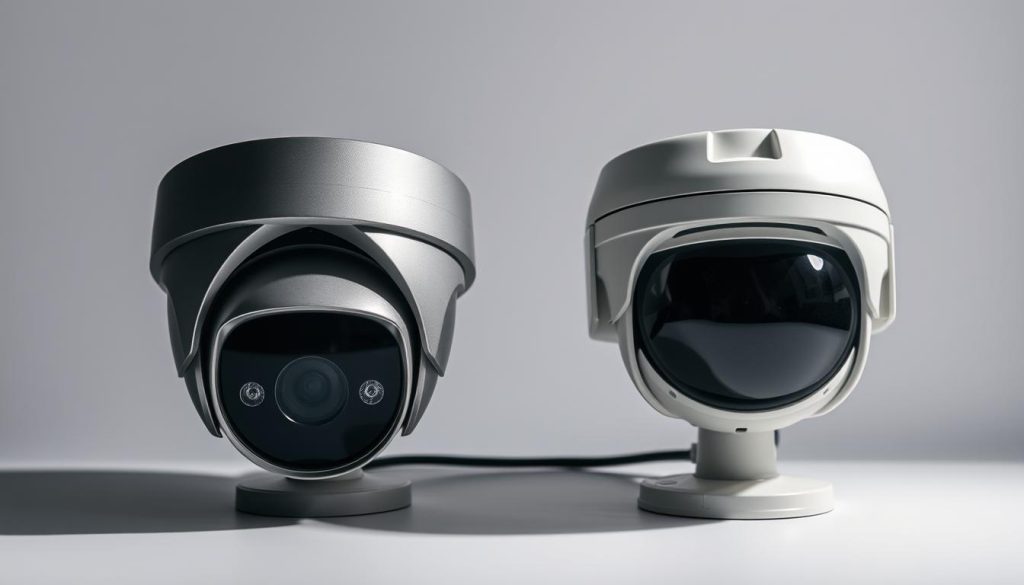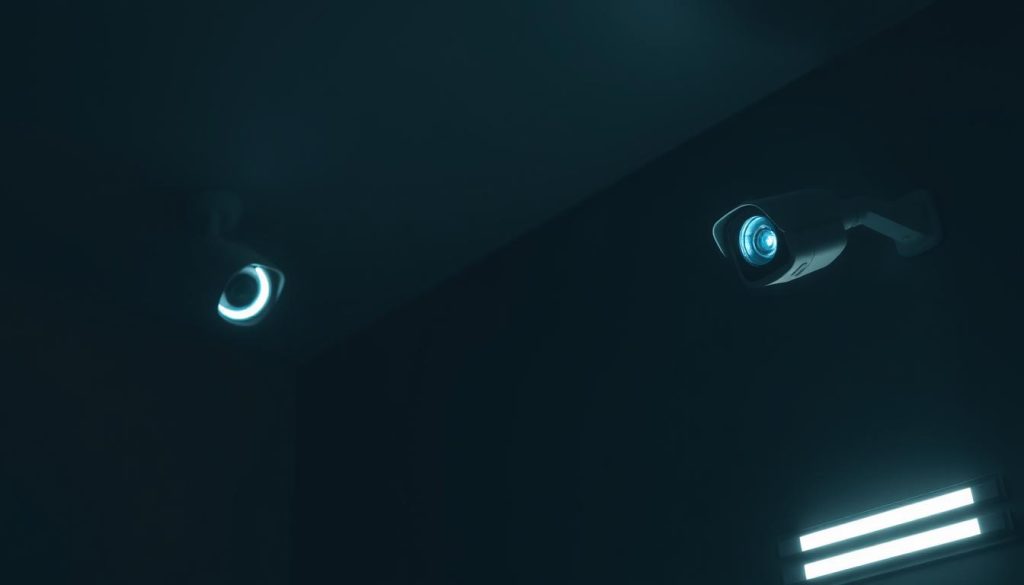Knowing if your CCTV status is active is key to protecting your property. This is even more important in places like Singapore, where surveillance is common. By checking if your CCTV cameras are working, you can make sure your systems are up and running.
This guide will show you how to check if your CCTV is on. You’ll learn how to confirm if your cameras are active. This way, you can be sure your security cameras are working right.
Key Takeaways
- Regular checks of your CCTV status enhance security.
- Understanding CCTV indicators can prevent vulnerabilities.
- Knowing how to verify if cameras are operational is essential.
- Effective monitoring systems are critical for property safety.
- Awareness of security camera functionality aids in timely upkeep.
Understanding CCTV Camera Types
Different CCTV camera types meet various surveillance needs. Each has its own features and uses. Knowing these types helps users see how they work.
- Dome cameras are best for indoor use. They are small and blend in, making them great for watching over small areas without being noticed.
- Bullet cameras are made for outdoor use. Their shape helps them stand out and keep intruders away. They give clear pictures and can handle all kinds of weather.
- PTZ cameras (Pan Tilt Zoom cameras) are very flexible. They can move and zoom in, letting users see more and focus on details. They’re perfect for watching over big areas.
Knowing what each CCTV camera type does helps figure out if they work right. It also helps choose the right one for different jobs.
Key Indicators of CCTV Functionality
It’s important to know the key signs of CCTV working right. These signs tell you if your security cameras are doing their job. They give you vital info about your surveillance setup.
Some common CCTV indicators include:
- LED lights: Many cameras have LED lights that show if they’re working. A steady light means the camera is on. A flashing light might show it’s recording or doing something else.
- Server connections: If your camera is connected to servers or networks, it’s sending video feeds as needed.
- Live feed accessibility: Being able to see live video feeds is a good sign the camera is working right.
- Recorded footage: If you can watch stored video, it means the camera is recording and working.
Knowing these signs helps keep your security systems working well. Regular checks on these points make sure your CCTV setup keeps watching over you. Watching these signs is a smart way to keep the areas you’re watching safe and secure.
How do I know if my CCTV is on or off?
To keep your home safe, it’s important to check CCTV status often. Knowing if your cameras are working right can make you feel more secure. There are a few ways to see if your cameras are recording.
Start by looking for signs like lights on the camera or recorder. Most systems have LED lights that show they’re on. When these lights flicker or stay steady, it means your cameras are capturing video.
Using security apps can also help. These apps let you see what your cameras see on your phone or computer. This way, you can quickly check if your system is working.
Using electronic bug detectors can also be helpful. These tools check if your cameras are getting power. Making sure your cameras are on is key to keeping your place safe. Regular checks help make sure your security system works well.
Visual Inspection Techniques for CCTV Cameras
Checking your CCTV cameras is key to knowing if they work right. You need to look for certain signs and movements. These tell you if your cameras are doing their job.
Checking for LED Indicators
LED lights show if your CCTV system is working. Different colors or patterns mean different things. A steady green light usually means everything is okay. But a red or flashing light might mean there’s a problem.
By watching these LED indicators, you can quickly tell if your cameras are working.
Observing Camera Movements
Watching how your cameras move is also important. Modern systems can move on their own. Look for smooth camera movements or actions.
If cameras don’t move when they should, it could be a sign of trouble. Checking these movements helps you fix any issues with your security system.
Using Security Camera Software
Using security camera software can really help you keep an eye on your CCTV system. It lets you access live feeds from your cameras. This way, you can see what’s happening in real-time.
It also has a dashboard where you can change settings, watch recorded videos, and get alerts for any problems.
With the right software, you can quickly check if your CCTV cameras are working right. The software is easy to use, making it simple to find important info. You can see if the cameras are connected, if there are any alerts, and if they’re recording.
Using this software means you can be sure your CCTV is on and working. It gives you peace of mind knowing your system is capturing footage as it should.
Utilizing Electronic Bug Detectors
Electronic bug detectors are great for checking if CCTV systems work. They find camera signals from active cameras. This lets users know if their CCTV is on.
For those worried about privacy, bug detectors are key. They help spot hidden surveillance cameras. Knowing how these tools work with your security is important.
Here’s what to keep in mind when using electronic bug detectors:
- Choose devices that can pick up many different camera signals.
- Make sure the detector is set up right to avoid false readings.
- Check different spots in your place to find all hidden cameras.
Adding bug detectors to your security plan makes your space safer. It also gives you peace of mind.
Power Supply and Connection Check
It’s important to make sure your CCTV system’s power and connections work well. A detailed power supply check and a look at the connection status can tell you a lot. They help spot problems early.
Examining the Power Indicator Lights
Start by looking at the power indicator lights on your CCTV cameras. These lights mean different things:
- Solid light: This usually means the camera has power and is working.
- Flashing light: It might mean the camera is trying to connect or needs help.
- No light: This could mean a problem with the power supply. You should check it right away.
Verifying Wired and Wireless Connections
Then, check both wired and wireless connections to make sure they’re good. For wired connections:
- Look for any wear or damage on the cables.
- Make sure the connectors are plugged in tightly.
If you’re using wireless technology:
- Check the connection status on your monitoring software to see if the camera is connected.
- Look for any interference that could mess with the wireless signal.
Doing these checks often can make your CCTV system more reliable and effective.
Common Troubleshooting Steps for CCTV Issues
Security camera problems can pop up without warning, causing frustration. Issues like lost video feed, power outages, and connection failures are common. To fix these, you need to know how to troubleshoot CCTV issues.
Start by checking if the power supply is working right. If there are no lights, it might mean a power problem. Look for blown fuses or bad outlets.
Then, check the cables and connections. Loose or damaged cables can cause big problems. Make sure everything is tight and replace any old or broken cords. This simple step can often solve many issues.
If problems keep happening, try testing the CCTV software. Go to the software interface to see if the camera settings are correct. Wrong settings can stop cameras from working right, leading to more problems.
For more help with CCTV troubleshooting, check out online guides like this detailed resource. By following these steps, you can make your CCTV system work better and keep your area safe.
Identifying Real vs. Fake CCTV Cameras
In today’s world, it’s key to tell real from fake CCTV cameras. Real ones help keep an eye on things, while fakes can trick people and weaken security. Knowing how to spot the difference is important.
Look for wiring first. Real CCTV cameras have wires showing they’re connected to power. Fake ones often don’t have wires, making them look empty.
LED lights are another clue. Real cameras have lights that blink or stay steady, showing they’re working. Fake cameras don’t have these lights, raising doubts about their purpose.
Brand names are also important. Well-known brands like Hikvision or Dahua have clear logos and quality. Be wary of cameras without clear brands.

Knowing these signs helps people spot real from fake CCTV cameras. This knowledge helps make better choices for keeping places safe.
Importance of Regular System Maintenance
Regular CCTV maintenance is key to keeping your surveillance system running smoothly. Systematic checks can make your equipment last longer and improve video quality. Both hobbyists and experts agree that system checks stop small problems from becoming big ones.
Cleaning camera lenses is a must for good surveillance. Dirt or smudges can block your view, making the system useless. Regular cleaning and software updates keep your system working well and secure. By focusing on maintenance, your cameras will work reliably without technical issues.
Here are important things to do in your maintenance routine:
- Cleaning camera lenses and sensors regularly.
- Updating software to the latest version.
- Checking power connections and data cables.
- Conducting periodic tests of all system components.
By adding these steps to your CCTV maintenance routine, you’ll see better performance. It also gives you peace of mind, knowing your system is working right. Regular surveillance upkeep is essential for strong security, making it a key part of any CCTV setup.
Consulting Professionals for CCTV Support
Getting professional CCTV support can really help your surveillance system work better. If you’re having trouble with installation or technical issues, experts can help. They know how to set up your system right, making it more effective for protecting your place.
Not all CCTV problems can be fixed by yourself. That’s where maintenance services come in. Experts have the skills and tools to quickly find and fix issues. Regular checks and maintenance can also stop problems before they start, keeping your system running smoothly for longer.
Getting expert help for your CCTV needs is key in today’s security world. By talking to specialists, you improve your surveillance and get solutions made just for you. Don’t wait to find professionals who can make your CCTV system a strong defense for your home or business.

